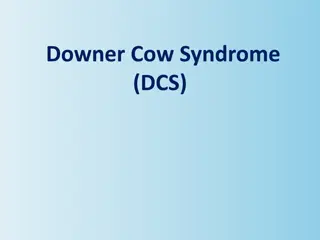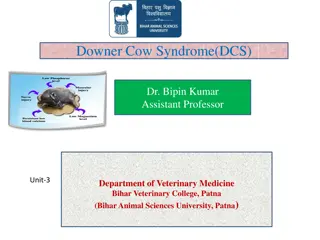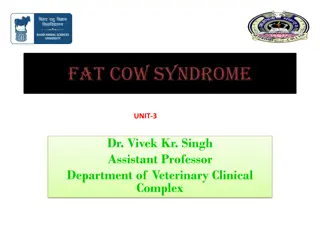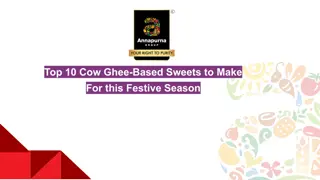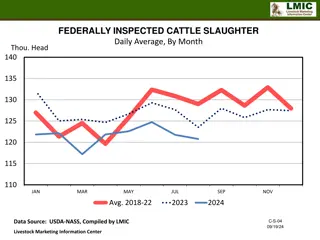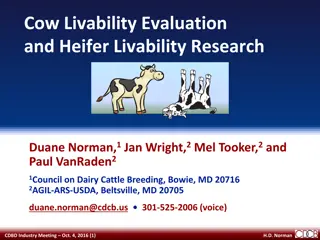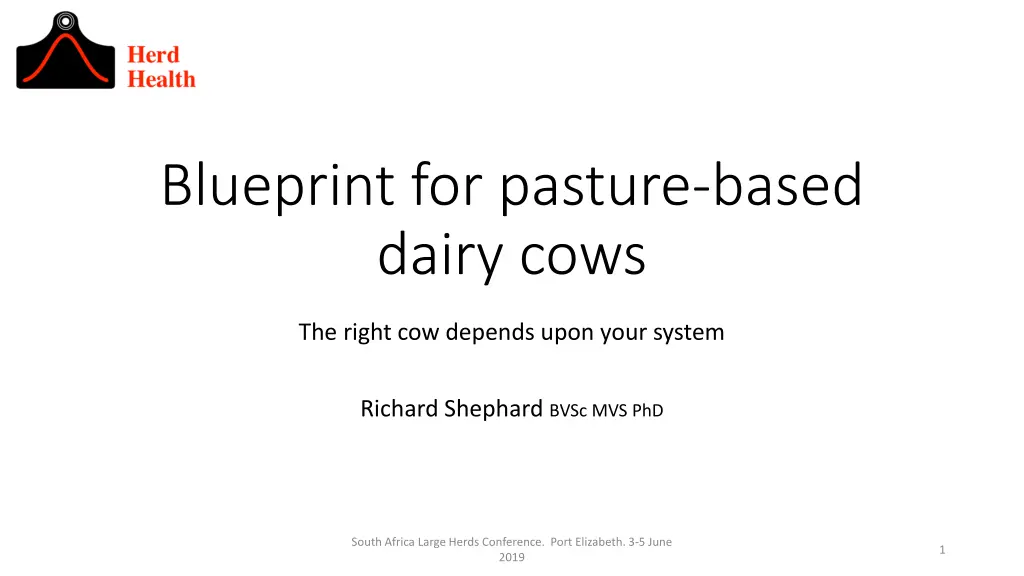
Pasture-Based Dairy Cow Management Insights
Explore key insights on pasture-based dairy cow management from Richard Shephard, a renowned veterinarian and farm management consultant. Learn about optimizing cow and land productivity, the influence of cow types on herd performance, and strategies for maximizing farm profitability. Gain valuable knowledge from the SA Large Herds Conference held in Port Elizabeth.
Download Presentation

Please find below an Image/Link to download the presentation.
The content on the website is provided AS IS for your information and personal use only. It may not be sold, licensed, or shared on other websites without obtaining consent from the author. If you encounter any issues during the download, it is possible that the publisher has removed the file from their server.
You are allowed to download the files provided on this website for personal or commercial use, subject to the condition that they are used lawfully. All files are the property of their respective owners.
The content on the website is provided AS IS for your information and personal use only. It may not be sold, licensed, or shared on other websites without obtaining consent from the author.
E N D
Presentation Transcript
Blueprint for pasture-based dairy cows The right cow depends upon your system Richard Shephard BVSc MVS PhD South Africa Large Herds Conference. Port Elizabeth. 3-5 June 2019 1
Richard Shephard Veterinarian, epidemiologist, farm management consultant Managed InCalf Project for Dairy Australia Explored role of genetics in pasture-based dairying Completed case studies examining cow-level and herd-level changes on farms SA Large Herds Conference. Port Elizabeth; 3-5 June 2019 2
Topics Cow-level performance versus herd-level performance Production Fertility My suggestions for ideal cow for pasture-based dairying Case studies Conversion from pure-bred to cross-bred cows in grazing system Fertility as the driver of long-term farm profitability SA Large Herds Conference. Port Elizabeth; 3-5 June 2019 3
Cow-level versus herd-level performance Atomistic fallacy assuming differences between cow types mean herds with different cow types always perform differently E.g. Cows of higher production capacity (once) had lower fertility. Many high-cow-producing herds were found to have higher fertility than low- cow-producing herds. Management made the difference! Just because herds have different cow types does not mean they always will perform differently SA Large Herds Conference. Port Elizabeth; 3-5 June 2019 4
Cow productivity versus land productivity Which should we optimise? Land or cow? Dairy farm land is worth 2+ times the value of the dairy herd Cows are intermediary in the milk production supply chain Land (pasture) is the primary generator of production SA Large Herds Conference. Port Elizabeth; 3-5 June 2019 5
Optimise the cow or the land Cow and herd performance by stocking rate on pasture providing 14 t DM/Ha/Yr (+2 T DM supplement) Superior cows produce more milk than inferior cows at low stocking rates. Cows are optimised at low stocking rates 2000 600 Cow production 427 kg MS cows 477 kg MS cows Herd Production 427 kg MS cows 477 kg MS cows 550 Pasture use optimises at high stocking rate Differences in cow production between superior and inferior cows lessen Herd production ceiling is set by pasture 1500 500 Kg MS/Cow/Yr Kg MS/Ha/Yr 450 1000 400 Total farm production is mostly independent of cow type at high stocking rate Determined by amount pasture consumed 350 500 300 Try to optimise the suite of resources 1 2 3 4 5 6 Stocking Rate (Cows/Ha) SA Large Herds Conference. Port Elizabeth; 3-5 June 2019 6
Pasture use efficiency Poor pasture use efficiency at low stocking rate Cows have few constraints so perform to potential Pasture use efficiency by stocking rate (pasture potential: 14 t DM/Ha/Yr) 100 Pasture efficiency 427 kg MS cows 477 kg MS cows 80 Pasture efficiency (%) 60 Pasture use efficiency maximizes at high stocking rate Cows are now somewhat underfed 40 20 High-producing cows eat more so you need fewer to eat all feed resources than for low-producing cows 0 1 2 3 4 5 6 Stocking Rate (Cows/Ha) SA Large Herds Conference. Port Elizabeth; 3-5 June 2019 7
If only it were than simple Average/total production tells nothing about efficiency Marginal response curve High efficiency Low efficiency Critical to know efficiency of last unit of production Output Cow types may differ in their efficiency at converting feed into milk ALL cows require different amounts of feed to produce an extra litre of milk Be careful interpreting average physical benchmarks! Input SA Large Herds Conference. Port Elizabeth; 3-5 June 2019 8
Inefficiency Cow and herd performance by stocking rate on pasture providing 14 t DM/Ha/Yr (+2 T DM supplement) More milk per cow may not be profitable if it too much feed is needed to get that last litre 2000 600 Cow production 427 kg MS cows 477 kg MS cows Herd Production 427 kg MS cows 477 kg MS cows 550 1500 500 Kg MS/Cow/Yr Kg MS/Ha/Yr Situations exist where it will be better to give extra feed to a hungrier cow she will make more milk with it 450 1000 400 350 500 Practically, you use stocking rate to redistribute pasture and keep herd most efficient 300 1 2 3 4 5 6 Stocking Rate (Cows/Ha) SA Large Herds Conference. Port Elizabeth; 3-5 June 2019 9
In economic terms Moving from the left curve to the right curve (via stocking rate) Reduce cow production but increase feed conversion efficiency 0.25 1.0 Output Output The farm may make now more milk from the same inputs 1.0 1.0 Input Input SA Large Herds Conference. Port Elizabeth; 3-5 June 2019 10
What clues about efficiency can we get? 1 kg DM pasture/concentrate contain 11 12 MJ ME Cows making 1 L milk (75 grams milk solids) requires 5.0 9.4 MJ Could produce between 0.5 2 litres of milk from 1 kg extra grain If herd regularly returns >1L (75gm MS) per kg supplement, cows are likely on an efficient part of the curve SA Large Herds Conference. Port Elizabeth; 3-5 June 2019 11
Should we keep stacking the cows on? Certainly not! Once stocking rate ensures most pasture is consumed, additional cows get most of their intake as supplement Remember, you need 1.7-2.0 tonnes of feed for maintenance, pregnancy Milk:concentrate price ratio rarely favourable for this to be profitable Why buy pasture land and run a feedlot? SA Large Herds Conference. Port Elizabeth; 3-5 June 2019 12
What can we conclude about production? 1. Profitability primarily determined by pasture consumption. Stocking rate is key. 2. Herds of lower-merit cows can produce at least as much milk from the (limited) feed base as herds ofhigher-merit cows 3. Set stocking rate to consume all pasture. This requires supplementation to maintain body condition and fertility. 4. Monitor herd milk response to supplement is it efficient (>1L/kg)? Ask yourself: Did you profit from the last litre of milk you produced? SA Large Herds Conference. Port Elizabeth; 3-5 June 2019 13
Fertility & pasture-based (seasonal) dairying Declining cow fertility has two main impacts: depreciation & risk Low fertility cows are lost prematurely. Herd depreciation increases Harder to maintain seasonal calving with low fertility cows. Changing when cows calve may increase failed season risk We have seen this in the Australian industry across the past 20 years SA Large Herds Conference. Port Elizabeth; 3-5 June 2019 14
Herd depreciation a real cost Think of cull cows as an expense, not a source of income Component Value ($AUD) Point-of-calving heifer $2,500 Cull cow $750 Your loss is the replacement value less the cull cow return Depreciation $1,750 Annual loss is determined by how long she remains in the herd If the cow lasts 1 yr $1,750 p.a. 2 yr $875 p.a. 3 yr $583 p.a. 4 yr $438 p.a. Aim to have a low replacement rate. Rates of 18 20% are achievable 5 yr $350 p.a. 6 yr $292 p.a. SA Large Herds Conference. Port Elizabeth; 3-5 June 2019 15
Adding one more productive year Increasing from 5 to 6 lactations per cow will reduce cow depreciation from $350 to $292 per annum A saving of around $60 You would need to produce an extra 20 kg milk solids At milk price of $6.00 kg & (efficient) marginal cost of production of $3.00 kg This means a 447 kg MS/Year x 5 lactation cow has the same annual profitability as a 427 kg MS/Year x 6 lactation cow Need to consider capital and running (depreciation) costs to estimate profit SA Large Herds Conference. Port Elizabeth; 3-5 June 2019 16
Fertility and risk changing calving pattern The average season is not the one that hurts you Warragul, Victoria, Australia (dry-land, high rainfall, late-winter/spring calving) Season Season average rainfall (mm) % of years with > 225 mm per season (75 mm/month) Rainfall patterns (in Australia) do not support additional calving times Autumn Winter Spring Summer 244 268 289 194 53% 74% 80% 31% It is very difficult to manage cows that calve into no green feed Despitewhat the factory pays! It s not a premium SA Large Herds Conference. Port Elizabeth; 3-5 June 2019 17
Production & fertility: cost of production Increased cow fertility Cows may have more lactations this decreases herd depreciation Herd calving pattern can be more easily managed to fit pasture growth Increased cow productivity Need to purchase or grow more feed or she just steals from herd mates Marginal feed costs tend to be higher than pasture feed cost Improved fertility may reduce your cost of production Increased cow productivity may increase your cost of production SA Large Herds Conference. Port Elizabeth; 3-5 June 2019 18
The ideal cow for pasture-based dairying Absolute must haves: 1. High fertility 2. Efficient grazers 3. Efficient feed converters These cows tend to be of modest size and production. The FxJ crossbreed More focus on herd efficiency, less focus on cow production potential. A well managed herd will offset many apparent cow deficiencies SA Large Herds Conference. Port Elizabeth; 3-5 June 2019 19
Case Study 1. Malmo & van Wees Seasonal (spring) calving, pasture-based (irrigation) herd Cows fed 1-2 T/cow/year concentrate Originally, HF, then two-way cross(with J) around 20 years ago. Now 3x cross Complete physical and financial records SA Large Herds Conference. Port Elizabeth; 3-5 June 2019 20
Crossbreeding Two-way cross predominated from 2006 Three-way cross has not yet stabilised in herd A few pure-bred HF remain SA Large Herds Conference. Port Elizabeth; 3-5 June 2019 21
Stocking rate Stocking rate increased as the herd converted to the smaller crossbreed 4.5 4.0 Stocking rate (Cows/Ha) 3.5 3.0 2.5 2.0 2002 2004 2006 2008 2010 2012 2014 Year SA Large Herds Conference. Port Elizabeth; 3-5 June 2019 22
Trends in cow and hectare milk production Cow annual production is increasing 2000 600 1800 1600 Hectare Kg MS/pa Hectare annual production is increasing at a faster rate than cow production Cow Kg MS/pa 500 1400 400 1200 1000 300 800 2002 2004 2006 2008 2010 2012 2014 Year Year SA Large Herds Conference. Port Elizabeth; 3-5 June 2019 23
Cow lifetime production Cow lifetime production is increasing at a faster rate than cow lactation production 600 2400 550 Cow lifetime Kg MS (avg) 2200 Cow Kg MS/pa (avg) 500 2000 450 Cows have more lactations 400 1800 350 1600 Fertility improvement has delivered real benefits 300 2001 2002 2003 2004 2005 2006 Year / Year of first lactation SA Large Herds Conference. Port Elizabeth; 3-5 June 2019 24
Cow and hectare gross margin trends Cow gross margin performance plateaued for many years 1400 4000 1200 Hectare GM/pa ($) 3000 Cow GM/pa ($) 1000 Hectare gross margin has consistently increased 2000 800 1000 600 Stocking rate was used to offset smaller cow effect 2002 2004 2006 2008 2010 2012 2014 Year SA Large Herds Conference. Port Elizabeth; 3-5 June 2019 25
Malmo & van Wees Farmers queue to buy their cull cows One of the only dairy sheds that shuts off in winter in my district Jakob and Hans take regular overseas holidays when the cows are dry 11.5% return on capital in year of analysis (a low milk price year) SA Large Herds Conference. Port Elizabeth; 3-5 June 2019 26
Case Study 2: AgCap AgCap investment fund with dairy portfolio Tasmanian farm milking 800 spring-calving cows 240 Ha, 190 Ha irrigated. High quality feed in spring and summer Consume 3.2T DM/Cow/Yr; 11 T pasture DM/Ha/Yr Grain prices are high in Tasmania; pasture is lowest cost feed Produce 480 kg MS/cow/yr; 1,620 kg MS/Ha/Yr Fertility is the key to farm profitability & sustainability SA Large Herds Conference. Port Elizabeth; 3-5 June 2019 27
Reproduction: key to performance Good reproductive performance is a key to a simple and profitable farming system. It assists us in maintaining our simple system Cows provide 6 lactations on average Herd replacement rate is 18-20%. This minimizes depreciation Cost savings in mating program and heifer rearing Short AI (3 weeks); short mating (8-10 weeks) keeps staff focused Minimal interventions; the cows are fertile without much help SA Large Herds Conference. Port Elizabeth; 3-5 June 2019 28
Farm performance Farm achieved 6.00% return on assets In a high cost-of-production year Ten-year profitability is in top 10% of farms The farm is reliably profitable; year after year SA Large Herds Conference. Port Elizabeth; 3-5 June 2019 29
Thank-you Dr Richard Shephard BVSc MVS PhD Herd Health Pty Ltd c/o 2 Foster Street Maffra VIC 3860 richard@herdhealth.com.au SA Large Herds Conference. Port Elizabeth; 3-5 June 2019 30



